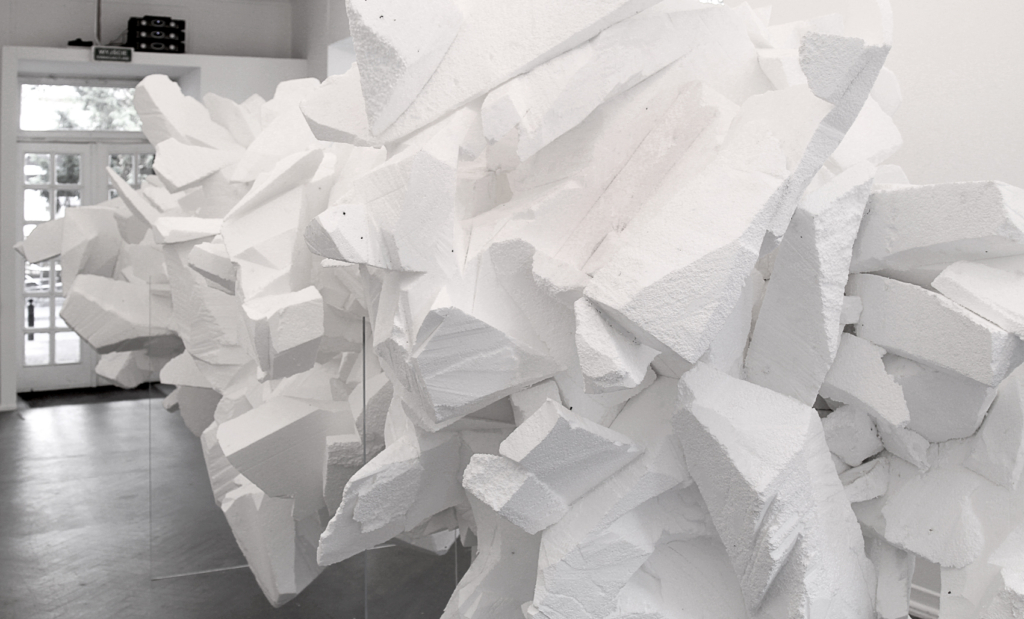
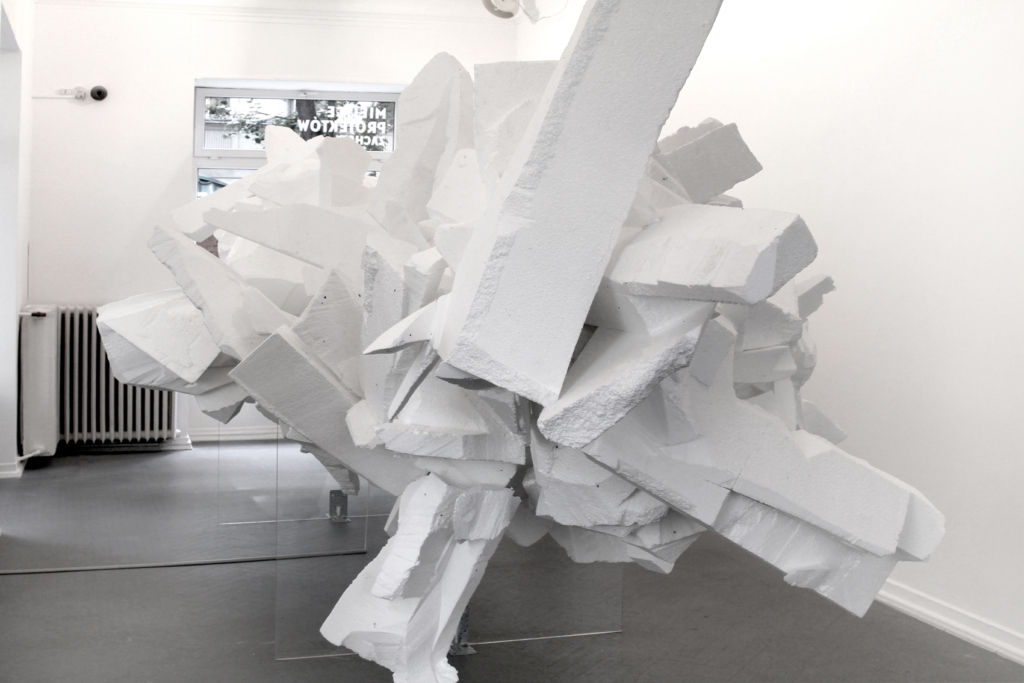
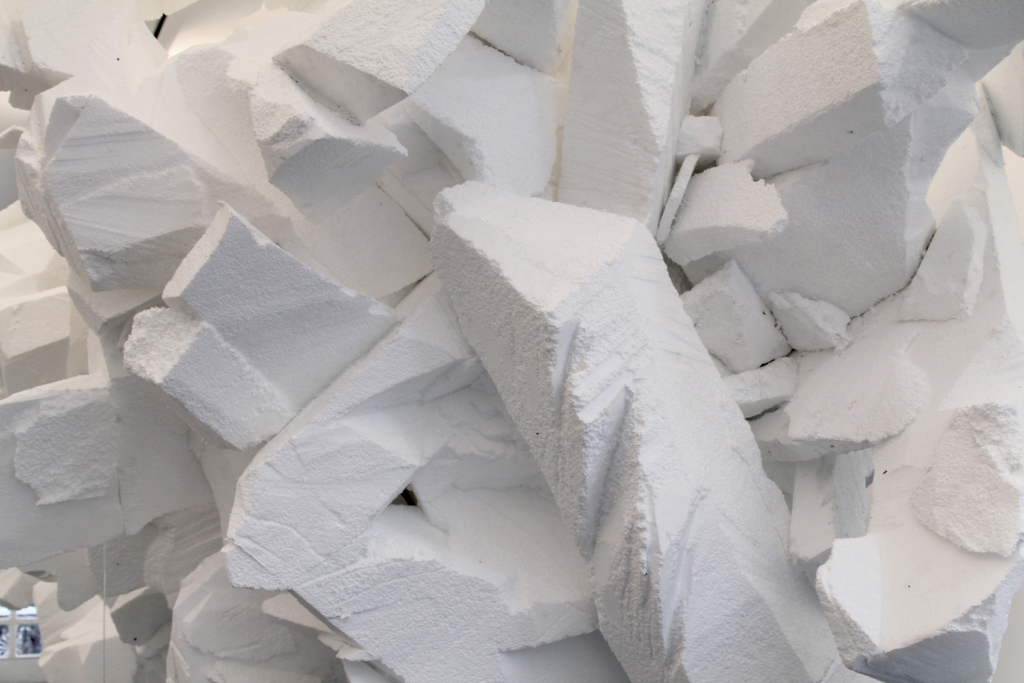
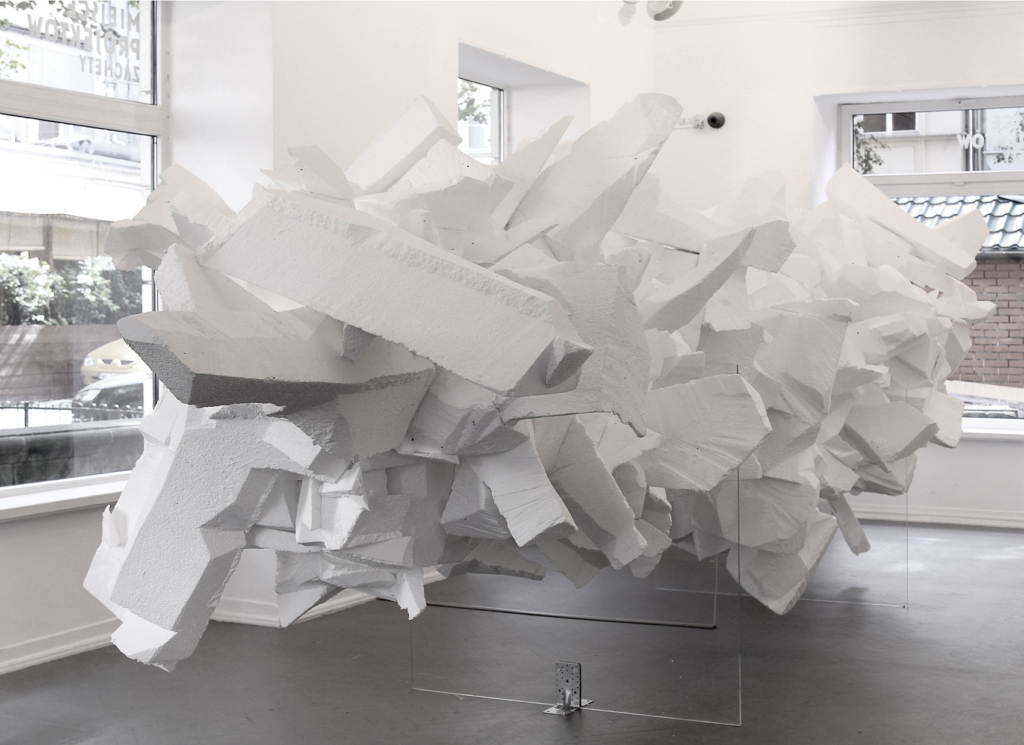
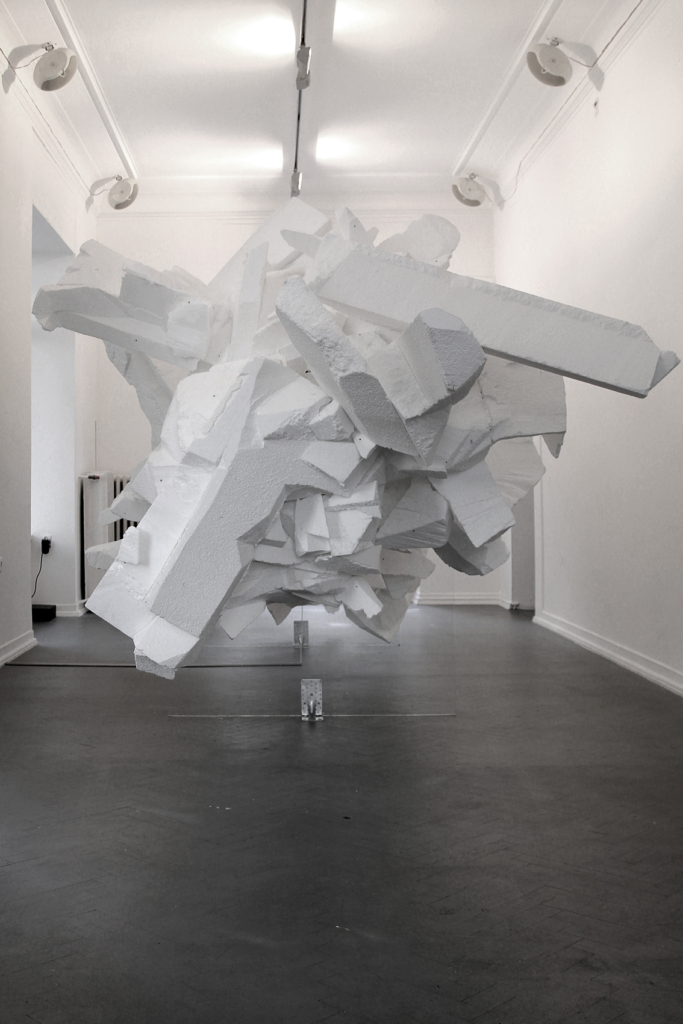

CATERPILLAR Material: styrofoam, steel, pleksiglas; Dimension: 670 x 280 x 280 cm; Date: 2018
CATERPILLAR
Zachęta Project Room – Zachęta National Art Gallery
26/05 – 22/07/2018
curator Magda Kardasz
“CATERPILLAR is an allegory of the movement of bodies, the rhythm of nature, organisms and evolutionism. In its assumption, it refers to the determinism of continuous change, the struggle for the survival of every matter.
CATERPILLAR is a part of a process of events, which continues endlessly. It is a form of a bizarre mechanism, a great clock, where time and space are a relative unity. The elements rotating at different speeds do not allow the viewer to identify and observe any regular layout. The form seems to be an incidental, a magnetised body attracting dozens of crushed, angular objects, like clusters of unspecified minerals set in circular motion.” – Mateusz Dąbrowski
Sculptures came alive, prints sprang out of the frames.
“..For years my work has been connected with the problem of perception, or more precisely
with its limitations, visual manipulation. It concerns phenomena that we do not notice, do not
understand, but which exist and have an impact on man and reality..” Mateusz Dąbrowski
The favorite creative form used by Mateusz Dąbrowski is the translation of observations and feelings into abstract forms. In his latest project, CATERPILLAR, presented in the Zachęta Project Room (MPZ), the artist continues to explore the motifs, at the same time expanding the borders of the meaning of sculpture and printmaking – his favorite visual techniques. The CANAPONE sculpture presented in the gallery basement has the form of a large metal spring- generator set into vibration by infrasounds. They imitate waves we normally do not register, even though they have a huge influence on our mood or even on the way our bodies work. Only after a moment of looking at the object does the viewer notice the vibration of the metal rings, which build up gradually. The sculpture, seemingly still, takes on features of a living organism. The box carrying the sculpture, wadded with gray, fluffy felt similar to fur, increases the impression that you are dealing with a biological object. Close to the piece of art described above, the artist affixed prints cut out in foil to the wall. The black shapes look like living organisms, cells seen through the microscope, ghosts from a cartoon or Oriental calligraphy. Similar abstract forms, inspired by photographs, including traces of various objects, were hitherto printed by Dąbrowski on small sheets of paper. At the MPZ exhibition, the artist plays with size, enlarges the objects to enormous scale, building an unusual relation between the graphic sign and architecture. This simple measure effectively changes the perception of the lower rooms of the gallery. With the CATERPILLAR sculpture installation, created specifically for the Zachęta Project Room, the artist deepens his interest in problems from the border of art, philosophy and science. He experiments with a material that is new to him – Styrofoam. The first thing noticed by the viewer is a white, large, angular lump, which seems to float above the gallery floor. The object is similar to a huge caterpillar, a fragment of an iceberg drifting on water, a cloud or a mechanism of unknown purpose. The industrial-like impression is strengthened by the gallery interiors – the author uncovered the old radiators and pipes that had been discreetly hidden behind white curtains during other exhibitions. Further contemplation allows the viewer to notice that the horizontal shape is movable – its components rotate about their axes, to different rhythms and in various directions. The sculpture has no single, final shape. It metaphorically refers to the relativity and subjectivity of time and movement. The importance to Mateusz Dąbrowski of acting on the verge of art, nature/corporeality and science/ technology is seen in the title given to the installation and to the exhibition as a whole. CATERPILLAR is not only the name of an animal species, but also a globally famous provider of mining and building machinery. Dąbrowski says about his kinetic, interactive sculpture: “The project is to be an allegory of the movement of celestial bodies, a representation of the rhythm of nature, of living organisms with various heartbeats and breathing patterns or different biochemical reaction times.” Evidently, the artist sees multiple possible readings of his art. We might call the CATERPILLLAR exhibition the praise of the constant change in time, an attempt to grasp the ongoing evolution of the world.
Magda Kardasz
Text published in the folder of the exhibition
Mateusz Dąbrowski CATERPILLAR
Zachęta Project Room – Zachęta National Gallery of Art
——————————————————————————————————————–
Rzeźby ożyły, grafiki wyszły z ram
“Moja praca od lat związana jest przede wszystkim z tematem percepcji, a właściwie z jej
ograniczeniami, manipulacją wizualną. Dotyczy zjawisk, których nie zauważamy, których nie
rozumiemy, a które istnieją i mają wpływ na człowieka i rzeczywistość.”
Mateusz Dąbrowski
Ulubioną metodą twórczą Mateusza Dąbrowskiego jest przekładanie obserwacji i wrażeń na formy abstrakcyjne. W swoim najnowszym projekcie CATERPILLAR, prezentowanym w Miejscu Projektów Zachęty, artysta kontynuuje te wątki, poszerzając jednocześnie granice pojęcia rzeźby i grafiki – swoich ulubionych technik wizualnych. Rzeźba CANAPONE, prezentowana w podziemiach galerii, ma formę dużej metalowej sprężyny-generatora, wprawianej w drgania przez infradźwięki. Imitują one fale, których zazwyczaj nie rejestrujemy, choć mają one duży wpływ na nasze samopoczucie czy nawet funkcjonowanie organizmu. Dopiero po chwili obserwacji obiektu widz zaczyna dostrzegać drgania metalowych okręgów, które się wzmagają. Pozornie statyczna rzeźba nabiera cech żywego organizmu. Obite włochatym, przypominającym sierść szarym filcem pudło, na którym ustawiona jest rzeźba, wzmacnia wrażenie biologiczności obiektu. W pobliżu opisanej pracy artysta umieścił na ścianie grafiki wycięte z folii. Czarne kształty przypominają żywe organizmy, komórki obserwowane pod mikroskopem, duszki z kreskówki czy dalekowschodnią kaligrafię. Podobne, inspirowane fotografiami abstrakcyjne formy, zawierające ślady przedmiotów, Dąbrowski odbijał dotychczas na papierze niewielkich rozmiarów. W MPZ bawi się skalą, powiększa kształty do ogromnych rozmiarów, budując niezwykłą relację graficznego znaku i architektury. Ten prosty zabieg skutecznie zmienia percepcję dolnych sal galerii. W stworzonej z myślą o przestrzeni Miejsca Projektów Zachęty instalacji rzeźbiarskiej zatytułowanej CATERPILLAR artysta pogłębia swoje zainteresowania z pogranicza sztuki, filozofii i nauki. Eksperymentuje z nowym dla siebie materiałem – styropianem. Widz zobaczy najpierw białą kanciastą bryłę dużych rozmiarów, wydającą się unosić nad podłogą galerii. Obiekt przypomina ogromną gąsienicę, fragment góry lodowej dryfujący po wodzie, obłok bądź mechanizm o nieznanym przeznaczeniu. Wrażenie industrialności wzmacnia widok wnętrza galerii – autor odsłonił stare kaloryfery i rury, na potrzeby innych ekspozycji skrzętnie ukrywane za białymi ścianami-zasłonami. Dłuższa kontemplacja pozwala dostrzec, że poziomy kształt jest ruchomy – jego poszczególne człony obracają się wokół własnej osi, w odmiennym rytmie i kierunku. Opisana rzeźba nie ma jednego, skończonego kształtu. Metaforycznie odnosi się do względności i subiektywności czasu oraz ruchu. O tym, jak ważne jest dla Mateusza Dąbrowskiego działanie na styku sztuki, natury/cielesności i nauki/techniki, świadczy tytuł nadany instalacji oraz całej wystawie. CATERPILLAR to po angielsku gąsienica, ale także znana na całym świecie firma produkująca maszyny górnicze i budowlane. O swojej kinetycznej, interaktywnej rzeźbie Dąbrowski mówi: „Projekt ma być alegorią ruchu ciał niebieskich, przedstawieniem rytmu natury, organizmów żywych o różnym rytmie serca i oddechu, czy odmiennym czasie reakcji biochemicznych”. Jak widać, artysta zakłada wielość możliwych odczytań swoich dzieł. Wystawę CATERPILLLAR można by nazwać pochwałą ciągłej zmienności w czasie, próbą uchwycenia nieustannej ewolucji zachodzącej w świecie.
Magda Kardasz
Tekst opublikowany w folderze do wystawy Mateusz Dąbrowski CATERPILLAR
Miejsce Projektów Zachęty – Zachęta Narodowa Galeria Sztuki
CATERPILLAR
.